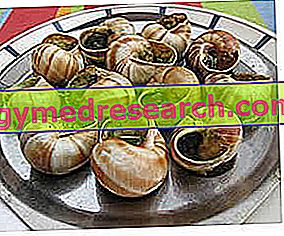The snails - improperly called "land snails" - are gastropod molluscs belonging to the Order of Stylommatophora .

The snails are equipped with SHELL and this feature differentiates them from the "properly said" snails, which belong to the Families: Arionidae and Limacidae . However, for convenience and comprehensibility in reading, below we will continue to use the term "edible land snails" as a synonym for "snails".
The shell (also called shell or shell) of the snails has a purely defensive purpose; it represents a valid shelter from the sun and summer heat, but also from cold and winter ice. This mollusk is therefore able to seal itself inside the shell by isolating itself by means of the secreted and dried burr. NB : The edible land snail uses the outer shell as a refuge from predators.
The shell of the snail is composed of mother of pearl; this species of "tissue" (partially organic but not sprayed) originates from the cutaneous secretion of perlucine, a protein-glycidic matrix; this substance, also called conchina, allows the formation and fixation of calcium carbonates (also secreted by the mollusc), which, by crystallizing, give the mother-of-pearl the characteristics of rigidity and stability. NB : On the shell of the snail (as on the clams of mussels and clams) the growth bands of the animal are clearly distinguishable.
Excluding the shell, the remaining visible portion of the body of land snails is called the foot ; this, facilitated by the lubrication of the burr secreted in the displacements, allows the animal to advance. Inside the shell, on the other hand, all vital organs are enclosed and protected, such as the liver, stomach, kidney, lung, etc. On the head of the snail (anterior to the foot) emerge two long and thin ocular appendages, and two small tentacles with a perceptive function. At the center and at the bottom (always with respect to the head) there is the buccal orifice, inside which the snails preserve a kind of toothed tongue (radula) which, by rubbing on the organic surfaces, removes small fragments.
Snails are vegetarian polyphagous animals (that is, that feed on all plants), but occasionally they take on a scavenger behavior; edible ground snails are extremely prolific as they reproduce by incomplete hermaphroditism.
Curiosity: snail slime is widely used as a cosmetic anti-aging ingredient, while in popular medicine the ingestion of live snails is described as an excellent remedy against gastritis and gastric ulcers.
Snail In Wet
X Problems with video playback? Reload from YouTube Go to Video Page Go to Video Recipes Section Watch the video on youtubeCulinary aspects
The snails ( Helix promatia and Cornu aspersum ), to be cooked, require purgation treatment from slime, feces and other impurities. The procedure is rather sadistic as it does not save the animal from suffering.
| Nutritional composition of the Snail - Reference values of the INRAN Food Composition Tables | ||||||||||||||||||||||||||||||||||||||||||||||||||||||||||||||||||||||||
 | ||||||||||||||||||||||||||||||||||||||||||||||||||||||||||||||||||||||||
Nutritional values (per 100 g of edible portion) | ||||||||||||||||||||||||||||||||||||||||||||||||||||||||||||||||||||||||
| ||||||||||||||||||||||||||||||||||||||||||||||||||||||||||||||||||||||||
The best seasons for the purchase of FRESH edible land snails are autumn and winter (October to April), beyond which the mollusk risks acquiring a bad taste maturing high concentrations of molecules toxic to humans.
The purgation of the snails lasts several days (from 2-3 days to 2-3 weeks depending on the sources consulted) and takes place inside a closed but well-ventilated container, in which the animals are left DIGIUNI, possibly located in a room fresh and in the shade.
Following the "bleeding", edible ground snails must be washed both in running water and in warm, salted water, with or without vinegar, to remove foam and residues. The operation must be repeated several times, handling them gently, but continuously, until the washing water is clear.
After leaving them to drain, it is then necessary to boil them alive in a pot with boiling water for at least a couple of hours, taking care to foam the surface of the liquid frequently. At the end of cooking, the snails can be shelled comfortably and prepared in various ways: burgundy, stewed, marchigiana, bordolese etc. NB : Eobania vermiculata edible ground snails have a much simpler preparation method but their consumption is decidedly less widespread.
To make them come out "spontaneously" from the shell, some advise starting cooking in a large saucepan covering them with water and heating on a very low flame, so that the heat urges them to leave the shell. As soon as all the snails have gone out, the flame must be raised considerably so that they remain blocked outside the shell.
Nutritional characteristics
The snails are gastropods with meats rich in proteins of high biological value and extremely lean, even if no details are available on the cholesterol content and on the breakdown of the fatty acids they contain.
Edible ground snails bring a very low energy value and, if boiled (without adding seasoning fats), they could easily fit into the low-calorie diet against overweight; however, it is necessary to specify that the snails are NOT easily digestible foods and that the MAXIMUM advisable portion corresponds to about 10-12 mollusks per head, while the average portion could fall between 5 and 6 pieces per adult person.
Detailed information on the supply of snail salts and vitamins is not available.



